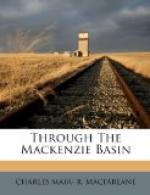The Red River, which joins the Peace about twenty-five miles below the Chutes, flows from the south with a course, it was said, of about two hundred miles, and up this beautiful stream there are extensive prairies. The soil is very rich at the confluence, and we noticed that in the garden at the little Hudson’s Bay Company’s post, where we transacted our business, vegetables and potatoes were further advanced than at Vermilion, and some ears of wheat were almost ripe. From statements made we judged this to be a region well worth special investigation; it was, in fact, one of the most inviting points for settlement we had seen on our journey.
Following down the Peace, some shoaly places were met with in the afternoon, the banks being low, sandy and uniform, with open woods to the south. The current was stately, but so slow that oars had often to be used. A chilly sunset was followed by an exceedingly brilliant display of Northern Lights, called by the Crees Pahkugh ka Neematchik—“The Dance of the Spirits.” This generally presages change; but the day was fine, and next morning we passed what are called the Lower Rapids, below which the banks are lined by precipitous walls of limestone, the river narrowing to less than half of its previous width.
Landing at Peace Point, the traditional scene of the peace between the Beavers and the Chipewyans, or between the Beavers and the Crees, as Mackenzie says, or all three, we found it to be a wide and beautiful table-like prairie, begirt with aspens, on which we flushed a pack of prairie chickens. Below it, and looking upward beyond an island, a line of timber, fringed along the water’s edge with willows, sweeps across the view, met half-way by a wall of Devonian rock, whose alternate glitter and shade, in the strong sunshine streaming from the east, seemed almost spectral.
The heavily timbered island added to the effect, and, with a patch of limestone on its cheek, formed a strikingly beautiful foreground.
The only exciting incident of the day was the vigorous chase, by some of the party, of an old pair of moulting gray geese with their young, all, of course, unable to fly. It was pitiful to watch the clever and fearless actions of the old birds as decoys, falling victims, at last, to parental love. Indeed, they were not worth eating, and to kill them was a sin. But when were there ever scruples over food on Peace River, that theatre of mighty feats of gormandism?




